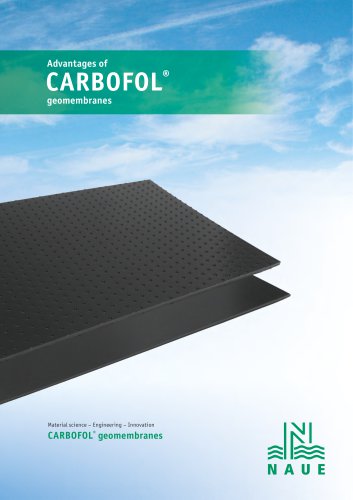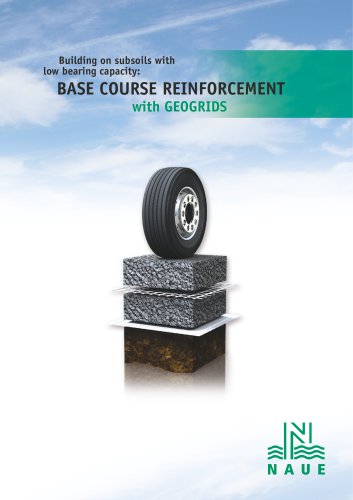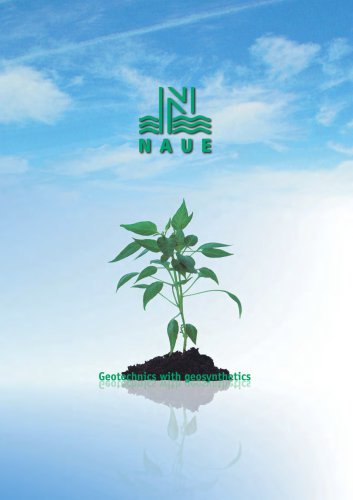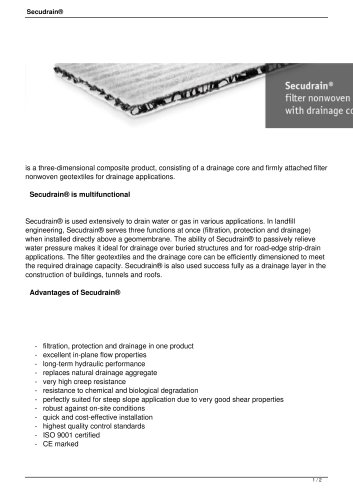
Catalog excerpts

Civil engineering
Open the catalog to page 1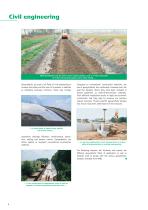
Civil engineering NAUE geosynthetics may be used in various system solutions, such as in road construction to increase the bearing capacity and to reduce rutting … Geosynthetics are used in all fields of civil engineering to increase the safety and life span of structures in addition to satisfying necessary functions. These may include: Compared to conventional construction materials, the use of geosynthetics has continually increased over the past few decades. Hence they have been included in several guidelines as state-of-the-practice materials. Their efficient installation results in...
Open the catalog to page 2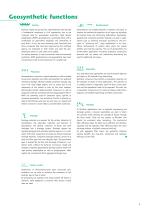
Geosynthetic functions Sealing Acting as liquid and gas barriers, geomembranes have become a fundamental component in civil engineering, due to the increased need for groundwater protection. High density polyethylene (HDPE) geomembranes, specifically those with a certification by government regulators and thicknesses of more than 1.5 mm, are most commonly used. Personnel from those companies that have been approved by the certifying agency, are employed to both install and weld the geomembranes where an area needs to be sealed. For sealing purposes in road construction and environmental...
Open the catalog to page 3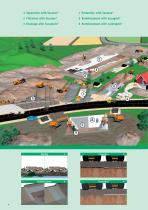
1 Separation with Secutex® 4 Protection with Secutex® 2 Filtration with Secutex® 5 Reinforcement with Secugrid® 3 Drainage with Secudrain® 6 Reinforcement with Combigrid®
Open the catalog to page 4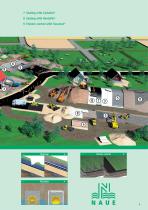
7 Sealing with Carbofol® 8 Sealing with Bentofix® 9 Erosion control with Secumat® Erosion control
Open the catalog to page 5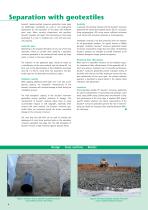
Separation with geotextiles Secutex® needle-punched nonwoven geotextiles (some types are additionally calendered) are used in civil engineering applications for the separation of soil layers with different grain sizes. When correctly dimensioned and specified, Secutex® prevents soil layers from intermixing or from being penetrated if a cover is installed over a soil with poor bearing capacity. Geotextile types Depending on the expected formation of ruts, one of the most important criteria to consider when selecting a separation nonwoven geotextile is the mechanical load caused by single...
Open the catalog to page 6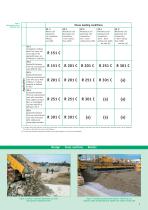
Table 1 Determination of the geotextile type To reduce rutting the thickness of the base course Layer can be increased and/or the shear strength of the base course can be improved and/or the base course can be reinforced. Test trials can be carried out to prove the efficiency. b) To ensure the separation performance products with a high elongation (> 50%) are recommended. Design Cross sections Details 7
Open the catalog to page 7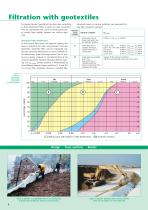
easy filter calculation approach. Filtration with geotextiles For decades Secutex® geotextiles have been used successfully calculation based on national guidelines may supersede this as three-dimensional filters in earth and road construction They are used between fine, coarse or mixed grained soils to provide filter stability between two distinct grain sizes. Mechanical filter effectiveness As with mineral filter layers, soil retention capacity also plays an important role when using Secutex® nonwoven geotextiles. Geotextile filters must be engineered such that the mechanical effectiveness...
Open the catalog to page 8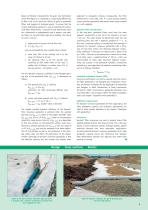
Based on filtration characteristics the grain size distribution area B from figure 5 is considered as a technically difficult soil to filter (risk of soil wash-out, failure of grain or geotextile filters and clogging of drainage layers). To ensure that the correct engineering approach is used to calculate the mechanical filter effectiveness, it should first be determined whether a hydrostatic or hydrodynamic load is present, and whether there is a soil with high single grain mobility. The criteria for such a soil are: 1. large portion of coarse silt and fine sand, 2. U = d60 / d10 < 5, some...
Open the catalog to page 9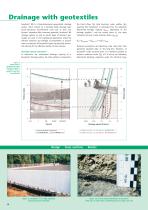
Drainage with geotextiles Secudrain® WD is a three-dimensional geosynthetic drainage system, which consists of a statically stable drainage layer (wave-structured monofilament core) and at least one Secutex® separation/filter nonwoven geotextile. Secudrain® WD drainage systems as well as special types of Secutex® geotextiles are used in civil engineering applications where the efficient collection and drainage of precipitation or groundwater are required. All Secudrain® layers are physically connected allowing for the effective transfer of shear stresses. Drainage capacity calculation To...
Open the catalog to page 10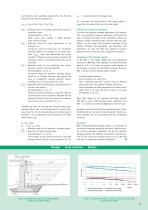
term thickness when specifying products (Fig. 10). The total reduction factor may be calculated as: FSIN = Reduction factor for localised deformation caused by installation loads. Recommendation: 1.0 to 1.5. (With coarser cover material, a higher reduction factor should be used.) FSCR = Reduction factor for creep deformation of the drainage core. (Long-term pressure-creep-curves for Secudrain® drainage systems are available. As discharge capacities Qlab,i,σ have been determined for various Secudrain® thicknesses, and have been correlated with excavation results, a 1.0 reduction factor FSCR...
Open the catalog to page 11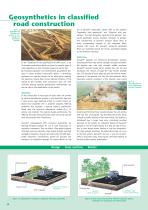
Geosynthetics in classified road construction use of Secutex® geotextiles, please refer to the chapters "Separation with geotextiles" and "Filtration with geotextiles". The high elongation capacity of the Secutex® nonwoven geotextiles ensures excellent resistance to damage. This characteristic of Secutex® products allows them to easily accommodate irregular or soft subgrades. When covered with stone, the Secutex® nonwoven geotextile fibers are reoriented around the stones, preventing damage to the nonwoven structure. Figure 15 Separation and filtration with Secutex® in a car testing track...
Open the catalog to page 12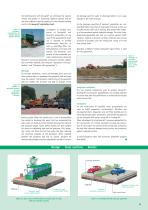
Soil reinforcement with Secugrid® can eliminate the need to remove and replace or chemically stabilise subsoils that do not have sufficient bearing capacity for the intended loading (ask for the Secugrid® calculation tool). Figure 19 Combigrid® increasing the soil bearing capacity (Mersin, Turkey) Combigrid® (a bonded composite of Secugrid® and Secutex® geotextiles) can be used if the geosynthetic product is required to provide reinforcement functions as well as separation-filter stability between cover layer and subsoil. The Secugrid® component of the composite provides reinforcement while...
Open the catalog to page 13All NAUE catalogs and technical brochures
-
Secugrid® HS
4 Pages
-
Combigrid®
4 Pages
-
Secugrid® PET/PP
4 Pages
-
CARBOFOL® geomembranes
4 Pages
-
geotextile introduction
4 Pages
-
SECUTEX® Soft Rock
4 Pages
-
MINING and GEOSYNTHETICS
11 Pages
-
BENTOFIX® X
4 Pages
-
BENTOFIX®
4 Pages
-
LANDFILL Engineering
13 Pages
-
Tunnel construction
16 Pages
-
NAUE_Renewable_wind_energy
8 Pages
-
Secugrid® PDF
3 Pages
-
Secudrain® PDF
2 Pages
-
Combigrid® PDF
2 Pages
-
Bentofix® PDF
3 Pages
-
Carbofol® PDF
3 Pages







